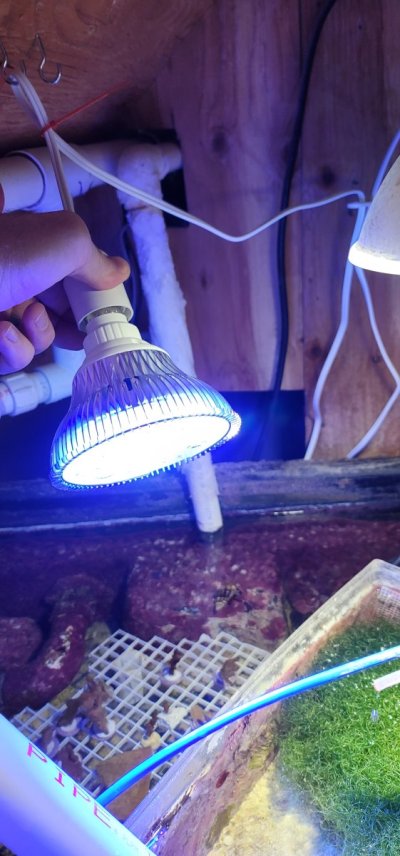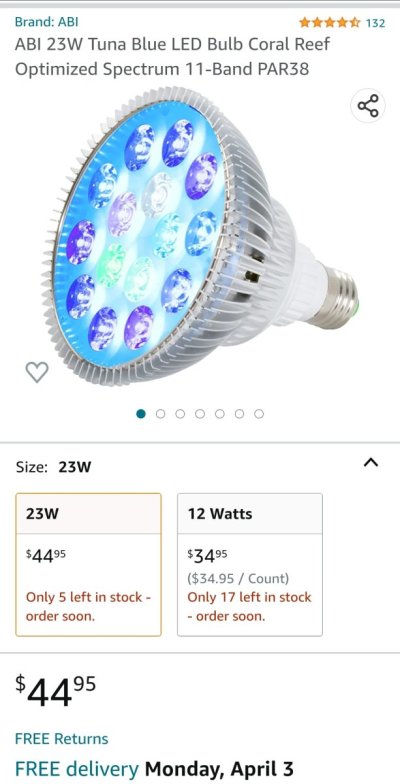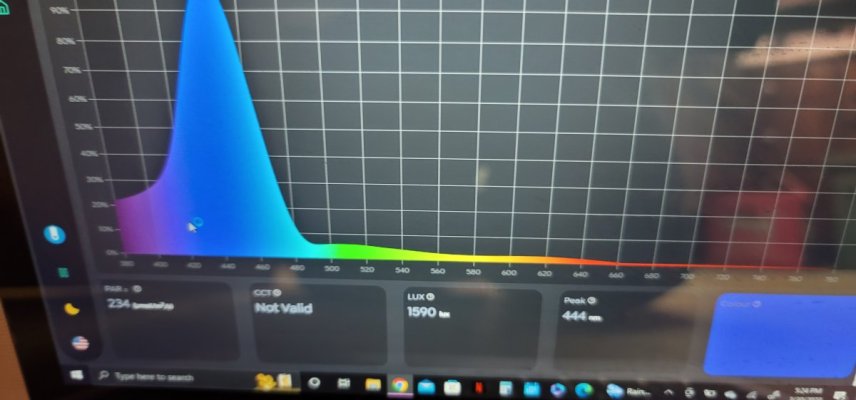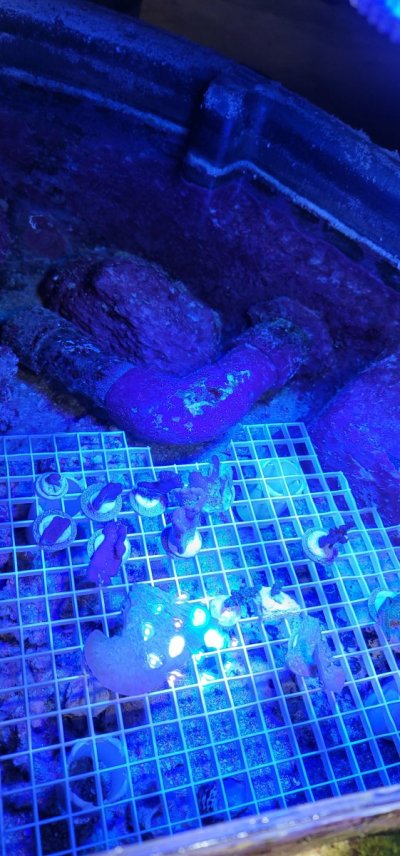Navigation
Install the app
How to install the app on iOS
Follow along with the video below to see how to install our site as a web app on your home screen.
Note: This feature may not be available in some browsers.
More options
You are using an out of date browser. It may not display this or other websites correctly.
You should upgrade or use an alternative browser.
You should upgrade or use an alternative browser.
Parwise
- Thread starter miller75
- Start date
- Tagged users None
- Joined
- Sep 18, 2017
- Messages
- 5,622
- Reaction score
- 3,456
440-450 is pretty much "royal blue" in led landOne thing I've noticed on the spectral output, is that most everyone that's posting has the same 447nm peak. Myself included. I don't know how accurate that is.
Try an ATI t5 ..see if the peak is lower ie around 430
Most mh's seem to peak higher than the t5's..
Yeah, that's the issue too, MH alone peaks at the same. This isn't my current PAR, but when I was testing different heights. This is MH only in the Pic below. The only thing that changes when I add the LED to the MH is more Violet and less green and red. The spectrum Peak stays identical.440-450 is pretty much "royal blue" in led land
Try an ATI t5 ..see if the peak is lower ie around 430
Most mh's seem to peak higher than the t5's..
And hey, who knows, maybe it's right.
Here are some readings from my DIY refugium light made up of a bunch of Amazon grow light LED strips:
Above the water:

Submerged 2 inches:

Nice job, except you have underwater selected for both readings. Don't worry took me a while to figure that out too, lol.
That's actually surprising that it has that much PAR and the spectrum is about perfect. Nice buy!
Have you adjusted your DT to reflect the PARwise PAR yet? Curious if you're noticing Any difference in your corals.
No, I haven't.That's actually surprising that it has that much PAR and the spectrum is about perfect. Nice buy!
Have you adjusted your DT to reflect the PARwise PAR yet? Curious if you're noticing Any difference in your corals.
The meter stopped working with my phone. It's very loose and can't get it to connect. If it does connect by some miracle, it's loose and wiggles free.
My wife's laptop is old but it does work with that. Just need to get some time so I can adjust everything.
No, I haven't.
The meter stopped working with my phone. It's very loose and can't get it to connect. If it does connect by some miracle, it's loose and wiggles free.
My wife's laptop is old but it does work with that. Just need to get some time so I can adjust everything.
Oh ok. Yeah, I have to watch how I move mine too. Maybe we need a holder for the phone connector lol.
Hey Guys -
A few of you noting that PARwise read
s 'under' what an Apogee says. I can't speak for their product and their repeatability/calibration but think you'd be surprised of the repeatability and quality of results from PARwise vs an actual lab grade spectrometer costing $$$$'s
Each PARwise is individually calibrated and individually QC'd against the spectral response against a lab quality spectrometer that is frequently factory calibrated for accuracy. We test across a range of spectra to ensure the repeatability and calibration is bang on.
We do not report light as PAR that is under 400nm. Apogee's published response curve for the MQ510 shows it responds to light under 400nm and as a result, will count this as 'PAR'. Try this for yourselves with a blacklight!!! I didn't know it could have so much PAR .
.
Because we can measure spectrum we can completely ignore any light energy that does not strictly fall between 400-700nm . A feature we hope to build on - in bringing comparative bands like the 'BRS Biology Band' if people want that kind of feature in the future. We do of course want to build in the photoresponse curves of various chlorophylls and then we can start producing selectable, comparable PUR results too.
. A feature we hope to build on - in bringing comparative bands like the 'BRS Biology Band' if people want that kind of feature in the future. We do of course want to build in the photoresponse curves of various chlorophylls and then we can start producing selectable, comparable PUR results too.
I think I mentioned in another post - PARwise doesn't have the fine single nanometer spectral resolution of a fully fledged spectrometer but it also doesnt have the price! That's why we call it a light meter and why you see 'smoother' graphs vs some published results from other spectrometers that cost 3-4x+ it's price. That doesn't mean to say its any less accurate.
We feel that the majority of reefers, myself included - dont really need this level of data. PARwise provides more than enough information and a very good spectral response for us to view to make use of it and make wise and comparative decisions about our lighting. Afterall at best we only have 8 light channels to play with.. not 300 for each spectrum between 400-700! If you do need or want single nanometer precision and read outs you need buy or rent a Seneye Spectra or similar - which can deliver this under water. Thats the device for that job.
If you do need or want single nanometer precision and read outs you need buy or rent a Seneye Spectra or similar - which can deliver this under water. Thats the device for that job.
A few of you noting that PARwise read
s 'under' what an Apogee says. I can't speak for their product and their repeatability/calibration but think you'd be surprised of the repeatability and quality of results from PARwise vs an actual lab grade spectrometer costing $$$$'s
Each PARwise is individually calibrated and individually QC'd against the spectral response against a lab quality spectrometer that is frequently factory calibrated for accuracy. We test across a range of spectra to ensure the repeatability and calibration is bang on.
We do not report light as PAR that is under 400nm. Apogee's published response curve for the MQ510 shows it responds to light under 400nm and as a result, will count this as 'PAR'. Try this for yourselves with a blacklight!!! I didn't know it could have so much PAR
Because we can measure spectrum we can completely ignore any light energy that does not strictly fall between 400-700nm
I think I mentioned in another post - PARwise doesn't have the fine single nanometer spectral resolution of a fully fledged spectrometer but it also doesnt have the price! That's why we call it a light meter and why you see 'smoother' graphs vs some published results from other spectrometers that cost 3-4x+ it's price. That doesn't mean to say its any less accurate.
We feel that the majority of reefers, myself included - dont really need this level of data. PARwise provides more than enough information and a very good spectral response for us to view to make use of it and make wise and comparative decisions about our lighting. Afterall at best we only have 8 light channels to play with.. not 300 for each spectrum between 400-700!
Thanks for the input!Hey Guys -
A few of you noting that PARwise read
s 'under' what an Apogee says. I can't speak for their product and their repeatability/calibration but think you'd be surprised of the repeatability and quality of results from PARwise vs an actual lab grade spectrometer costing $$$$'s
Each PARwise is individually calibrated and individually QC'd against the spectral response against a lab quality spectrometer that is frequently factory calibrated for accuracy. We test across a range of spectra to ensure the repeatability and calibration is bang on.
We do not report light as PAR that is under 400nm. Apogee's published response curve for the MQ510 shows it responds to light under 400nm and as a result, will count this as 'PAR'. Try this for yourselves with a blacklight!!! I didn't know it could have so much PAR.
Because we can measure spectrum we can completely ignore any light energy that does not strictly fall between 400-700nm. A feature we hope to build on - in bringing comparative bands like the 'BRS Biology Band' if people want that kind of feature in the future. We do of course want to build in the photoresponse curves of various chlorophylls and then we can start producing selectable, comparable PUR results too.
I think I mentioned in another post - PARwise doesn't have the fine single nanometer spectral resolution of a fully fledged spectrometer but it also doesnt have the price! That's why we call it a light meter and why you see 'smoother' graphs vs some published results from other spectrometers that cost 3-4x+ it's price. That doesn't mean to say its any less accurate.
We feel that the majority of reefers, myself included - dont really need this level of data. PARwise provides more than enough information and a very good spectral response for us to view to make use of it and make wise and comparative decisions about our lighting. Afterall at best we only have 8 light channels to play with.. not 300 for each spectrum between 400-700!If you do need or want single nanometer precision and read outs you need buy or rent a Seneye Spectra or similar - which can deliver this under water. Thats the device for that job.
Good to know moving forward.
- Joined
- Oct 28, 2018
- Messages
- 137
- Reaction score
- 116
I’m really having fun with the PARwise. Seeing the spectrum along with PAR gives interesting insights.
Here’s what I get for my DIY refugium lights under water:

and outdoors to see what sunlight looks like on an afternoon in Vancouver in April:

I would love to see a “save” option so we can save and add comments to spectrum/PAR readings. Right now it’s just screenshots. Even starting with saving screenshots would be a start but even better for future data use a file format that saves the underlying data would be optimal (perhaps as an excel spreadsheet format to allow universal import and sharing).
Here’s what I get for my DIY refugium lights under water:
and outdoors to see what sunlight looks like on an afternoon in Vancouver in April:
I would love to see a “save” option so we can save and add comments to spectrum/PAR readings. Right now it’s just screenshots. Even starting with saving screenshots would be a start but even better for future data use a file format that saves the underlying data would be optimal (perhaps as an excel spreadsheet format to allow universal import and sharing).
Do you have plans for the app?Hey Guys -
A few of you noting that PARwise read
s 'under' what an Apogee says. I can't speak for their product and their repeatability/calibration but think you'd be surprised of the repeatability and quality of results from PARwise vs an actual lab grade spectrometer costing $$$$'s
Each PARwise is individually calibrated and individually QC'd against the spectral response against a lab quality spectrometer that is frequently factory calibrated for accuracy. We test across a range of spectra to ensure the repeatability and calibration is bang on.
We do not report light as PAR that is under 400nm. Apogee's published response curve for the MQ510 shows it responds to light under 400nm and as a result, will count this as 'PAR'. Try this for yourselves with a blacklight!!! I didn't know it could have so much PAR.
Because we can measure spectrum we can completely ignore any light energy that does not strictly fall between 400-700nm. A feature we hope to build on - in bringing comparative bands like the 'BRS Biology Band' if people want that kind of feature in the future. We do of course want to build in the photoresponse curves of various chlorophylls and then we can start producing selectable, comparable PUR results too.
I think I mentioned in another post - PARwise doesn't have the fine single nanometer spectral resolution of a fully fledged spectrometer but it also doesnt have the price! That's why we call it a light meter and why you see 'smoother' graphs vs some published results from other spectrometers that cost 3-4x+ it's price. That doesn't mean to say its any less accurate.
We feel that the majority of reefers, myself included - dont really need this level of data. PARwise provides more than enough information and a very good spectral response for us to view to make use of it and make wise and comparative decisions about our lighting. Afterall at best we only have 8 light channels to play with.. not 300 for each spectrum between 400-700!If you do need or want single nanometer precision and read outs you need buy or rent a Seneye Spectra or similar - which can deliver this under water. Thats the device for that job.
Like mentioned, a save button?
Save button and have an overlay if you are adjusting lighting so you can see where you were and where you are presently would be fantastic! A game changer to adjusting LED lighting.
Hey Guys -
A few of you noting that PARwise read
s 'under' what an Apogee says. I can't speak for their product and their repeatability/calibration but think you'd be surprised of the repeatability and quality of results from PARwise vs an actual lab grade spectrometer costing $$$$'s
Each PARwise is individually calibrated and individually QC'd against the spectral response against a lab quality spectrometer that is frequently factory calibrated for accuracy. We test across a range of spectra to ensure the repeatability and calibration is bang on.
We do not report light as PAR that is under 400nm. Apogee's published response curve for the MQ510 shows it responds to light under 400nm and as a result, will count this as 'PAR'. Try this for yourselves with a blacklight!!! I didn't know it could have so much PAR.
Because we can measure spectrum we can completely ignore any light energy that does not strictly fall between 400-700nm. A feature we hope to build on - in bringing comparative bands like the 'BRS Biology Band' if people want that kind of feature in the future. We do of course want to build in the photoresponse curves of various chlorophylls and then we can start producing selectable, comparable PUR results too.
I think I mentioned in another post - PARwise doesn't have the fine single nanometer spectral resolution of a fully fledged spectrometer but it also doesnt have the price! That's why we call it a light meter and why you see 'smoother' graphs vs some published results from other spectrometers that cost 3-4x+ it's price. That doesn't mean to say its any less accurate.
We feel that the majority of reefers, myself included - dont really need this level of data. PARwise provides more than enough information and a very good spectral response for us to view to make use of it and make wise and comparative decisions about our lighting. Afterall at best we only have 8 light channels to play with.. not 300 for each spectrum between 400-700!If you do need or want single nanometer precision and read outs you need buy or rent a Seneye Spectra or similar - which can deliver this under water. Thats the device for that job.
Thanks for dropping in and adding that explanation. I was speaking to Craig at ITC and he was explaining the UV portion a couple of months ago. 8 believe I posted that on one of these threads, it always great to hear it directly from a great post.
@ITCreefculture I think with today's lighting being what it is, it would be very beneficial to be able to read 380nm and above. I do understand on the Spectra vs the PARwise and true UV is basically non-existent in the LEDs of today.
Great product and I've definitely helped the PARwise sales team out, haha. Not because I have any affiliation as I don't, but because it's a great product and one that Reefers like myself needed.
@ITCreefculture care to share some upcoming enhancements to the PARwise functionality?
- Joined
- Oct 28, 2018
- Messages
- 137
- Reaction score
- 116
@ITCreefculture if you’re taking suggestions:
1. I like the idea of user-selectable PAR ranges (PARwise default, Apogee 510 matched, BRS biology band, etc) - it highlights the flexibility of the PARwise. It’s hard to argue with the track record of the Apogee 510 even if it somewhat over includes spectra. Or, offering this might just confuse everyone so maybe just stick to your convictions as to how you report PAR!
2. If we can’t yet save results to a file, can we add a label (a note field) on the screen so screenshots can include a note without needing to manually add a label? I had to do it manually and it was tedious to map my tank. The notes field could also be useful for an exported record, too.
3. As mentioned before, on a Kindle 7 and 8, the Silk browser tab and addressbar takes up valuable real estate. Being able to scroll those off the screen would give more space for the spectrum, PAR/lux/peak boxes, and a user note field.
4. Right now on the Kindle you have to rotate the tablet into landscape mode to show the spectrum etc and it’s harder to hold that way with one hand - I’d like to see a dynamic layout that can use the portrait aspect ratio yet still show all the data on the Kindle screen without needing to scroll.
1. I like the idea of user-selectable PAR ranges (PARwise default, Apogee 510 matched, BRS biology band, etc) - it highlights the flexibility of the PARwise. It’s hard to argue with the track record of the Apogee 510 even if it somewhat over includes spectra. Or, offering this might just confuse everyone so maybe just stick to your convictions as to how you report PAR!
2. If we can’t yet save results to a file, can we add a label (a note field) on the screen so screenshots can include a note without needing to manually add a label? I had to do it manually and it was tedious to map my tank. The notes field could also be useful for an exported record, too.
3. As mentioned before, on a Kindle 7 and 8, the Silk browser tab and addressbar takes up valuable real estate. Being able to scroll those off the screen would give more space for the spectrum, PAR/lux/peak boxes, and a user note field.
4. Right now on the Kindle you have to rotate the tablet into landscape mode to show the spectrum etc and it’s harder to hold that way with one hand - I’d like to see a dynamic layout that can use the portrait aspect ratio yet still show all the data on the Kindle screen without needing to scroll.
Do some DLI measurements over a few days, when cloudy - it's amazing to see the difference in light levels with cloud and partial cloud cover!I’m really having fun with the PARwise. Seeing the spectrum along with PAR gives interesting insights.
Here’s what I get for my DIY refugium lights under water:

and outdoors to see what sunlight looks like on an afternoon in Vancouver in April:

I would love to see a “save” option so we can save and add comments to spectrum/PAR readings. Right now it’s just screenshots. Even starting with saving screenshots would be a start but even better for future data use a file format that saves the underlying data would be optimal (perhaps as an excel spreadsheet format to allow universal import and sharing).
I'm going to get the team to start packing a slip in the box to make note of this.Ive had one for about 2 weeks now and I love it. Very easy to use once you figure out the under water/ out of water button.
Thanks Hurricane! Do you go under a different name on the Official PARwise Owners group on facebook?Thanks for dropping in and adding that explanation. I was speaking to Craig at ITC and he was explaining the UV portion a couple of months ago. 8 believe I posted that on one of these threads, it always great to hear it directly from a great post.
@ITCreefculture I think with today's lighting being what it is, it would be very beneficial to be able to read 380nm and above. I do understand on the Spectra vs the PARwise and true UV is basically non-existent in the LEDs of today.
Great product and I've definitely helped the PARwise sales team out, haha. Not because I have any affiliation as I don't, but because it's a great product and one that Reefers like myself needed.
@ITCreefculture care to share some upcoming enhancements to the PARwise functionality?
We're a really small company and testimonials like that really help - there is no replacement for true user feedback and its often hard to come by as people look to complain before praise, often keeping praise to themselves. So thank you!
Nothing to share as yet but there will be in the future. We are DEEP into a new seneye project which I definitely can't talk about so don't ask
Similar threads
-
- AMS: Article
- Replies
- 11
- Views
- 1,380
- Replies
- 8
- Views
- 413





















